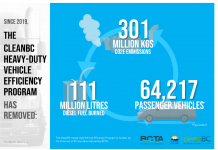Based on U.S. safety data from the United States that showed amber brake-activated pulsating lamps can have significant benefits to road safety, the Canadian Trucking Alliance board of directors requested that CTA staff and leading lighting technology and trailer equipment suppliers from CTA’s Team Canada Elite begin working with Transport Canada to clarify the allowance for the use of this technology on trucking equipment operated in Canada.
“Considering the immediate safety benefits of this technology based on the pilot testing in the U.S., this was a very straightforward decision for our Board. We are thankful to the carriers and CTA Team Canada Elite members for raising this issue and championing it through our policy process,” said Geoff Wood, CTA’s Senior VP Policy.
In late March, CTA received confirmation from Transport Canada that clarified there are no restrictions from Transport Canada’s perspective for the use brake-activated pulsating lamps, provided the technology does not impair the effectiveness of the required lighting standards. Excerpts from Transport Canada’s statement to CTA reads:
“With regards to brake-activated pulsating lamps, the regulation allows the installation of these devices as auxiliary lamps, as long as the minimum requirements in terms of lamp size, placement and colour of CMVSS 108 are met. However, the systems themselves must respect Technical Standards Document (TSD) 108 S6.2.1, no additional lamp, reflective device, or other motor vehicle equipment is permitted to be installed that impairs the effectiveness of lighting equipment required by this TSD. Full details of TSD 108 can be found by clicking here.
“It is also important to note that federal regulations specify the safety performance aspects of a vehicle as it is manufactured and delivered by the original manufacturer, but not its use, maintenance, or alterations made by dealers or vehicle owners. Provincial and territorial governments are responsible for regulations and enforcement strategies as they apply to maintenance, operation of motor vehicle lighting equipment and installation of aftermarket equipment. As such, vehicles retrofitted with amber brake-activated pulsating lamps must be compliant with the requirements in the province or territory within which they operate.”
Wood said the industry is “pleased to learn that the adoption of this technology can be seamless at the federal level and CTA is grateful to the team at Transport Canada for the rapid turnaround of our request.”
The provincial trucking associations in the Alliance continue to work with their respective governments to determine the suitability of amber brake-activated pulsating lamps. The response to date from the provincial/territorial governments via the provincial associations is as follows:
Ontario
“In Ontario, flashing amber lights are not regulated under the Highway Traffic Act (HTA), or subsequent regulations, except for when operating within the provinces Oversized/Overweight permitting regime whereby as per permit condition, flashing amber lights are not to be used except in situations prescribed within the permit. Section 142 (8) of the HTA allows for stop lamps to be red or amber. However, if the vehicle is equipped with a flashing red stop lamp, this would be in violation of Section 62(14) of the HTA …Thus, it can be concluded that the use of Amber Brake-Activated Pulsating Lamps in the upper center position or in an upper dual outboard position on the rear of trailers operated within Ontario are in-fact legal for application under the HTA and subsequent regulations. However, it is advisable that carriers only utilize Amber Brake-Activated Pulsating Lamp technology and not those equipped with red pulsating lamps as this would be in violation of the HTA, as stated above”.
Quebec
“The light impulsions produced by the braking light modulator before turning to a constant red can be interpreted by a law officer as a red blinking light which is reserved exclusively to emergency vehicles. The officer can therefore submit a ticket according to article 285 because the light doesn’t meet the requirements of article 239:
- No road vehicle, except a vehicle contemplated in sections 226 to 227.1, may carry alternately
flashing white headlights or flashing or rotating lights of whatever colour.
No road vehicle contemplated in any of sections 226, 226.2, 227 and 227.1 may carry flashing or rotating
lights of another colour than the colour authorized for that vehicle in accordance with the section which
applies to such a vehicle.
The owner of a road vehicle that does not meet the requirements of any of sections 239, 244, 245, 255
and 270 is guilty of an offence and is liable to a fine of $200 to $300.
Every owner or operator of a heavy vehicle that does not comply with section 244 is guilty of an offence
and is liable to a fine of $350 to $1,050.”
For additional jurisdictional allowances/prohibitions of this technology, please contact your respective provincial trucking association
Background
Over the course of the past few years National Tank Truck Carriers (NTTC) and Groendyke Transport (Oklahoma) asked the US Federal Motor Carrier Safety Administration (FMCSA) for permission to install Amber Brake-Activated Pulsating Lamps (PBL) not in lieu of, but in addition to, the required steady-burning brake lamps required by US regulation. That exemption was provided and the safety results were significant, showing a one-third reduction in rear-end collisions. Following the success of the first FMCSA exemption process granted specifically to tank-truck operations, Grote Industries (manufacturer of trailer lighting components) was also granted a five-year limited exemption by FMCSA on December 9, 2020 to address PBL technology on trailers.






















